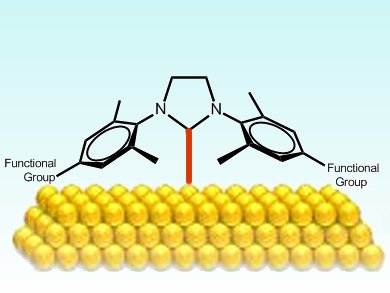Since the mid-1980s, sulfur-containing thiol bridges have been used to anchor coatings to gold surfaces for a wide range of applications in electronics, sensors, microfabrication, and nanotechnology. However, S-Au bonds have low conductance, which often limits their use. Moreover, moderate warming can lead to de-anchoring of monolayers because the S-Au bond is also relatively weak.
Jeremiah Johnson and colleagues, Massachusetts Institute of Technology (MIT), Cambridge, USA, have homed in on N-heterocyclic carbenes (NHCs) as one possible alternative to thiols. NHCs offer sigma-donating and moderate π-backbonding characteristics, which the team has now exploited in forming partially conjugated surface bonds on gold. They were then able to grow novel polymer brushes on the gold surface anchored on these units.
The rich chemistry of NHCs offers a wealth of possibilities for functionalization.
- Addressable Carbene Anchors for Gold Surfaces,
Aleksandr V. Zhukhovitskiy, Michael G. Mavros, Troy Van Voorhis, Jeremiah A. Johnson,
J. Am. Chem. Soc. 2013.
DOI: 10.1021/ja401965d



